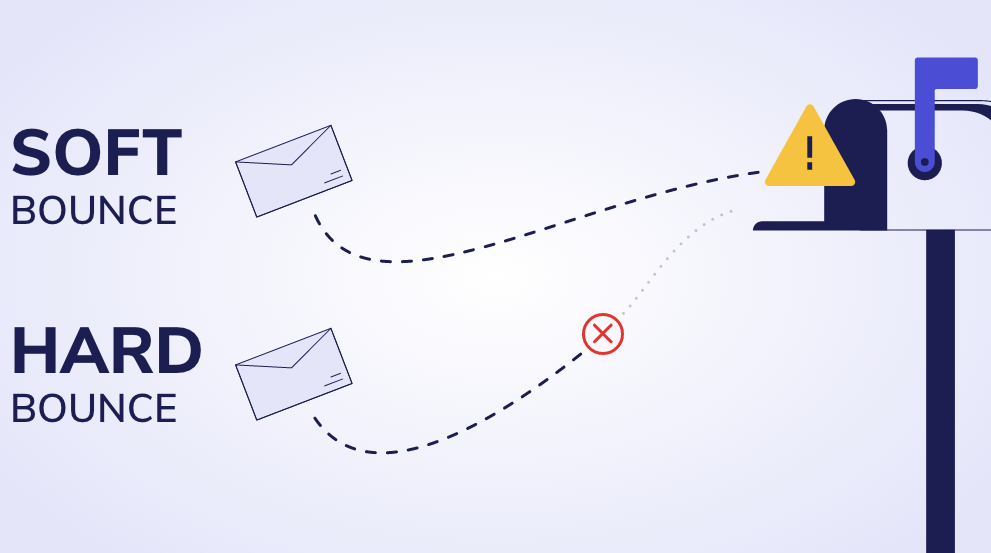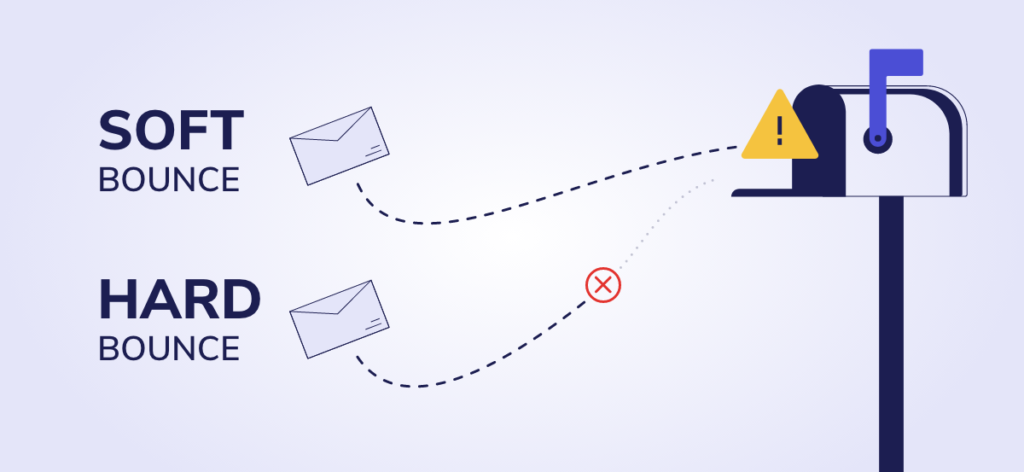“Understanding the Difference Between Hard and Soft Email Bounces

We know the feeling of immense frustration when you put your heart and soul into crafting emails, only to find out some weren’t delivered. You might think, “Oh well, I might just write new emails,” and start working on a new email. But here you’re ignoring the underlying problem.
Email bounce can mean that something is wrong with your email deliverability. If your email bounce rate is high, chances are your domain will be blacklisted by most ISPs. Not a pretty thing, am I right?
So, you need to understand that email bounce rate is critical to control and learn about the types of email bounce you can encounter. This blog will discuss email hard and soft bounces, the main difference between them, and how you can control them.
What is a bounced email?
A bounced email is a message returned to the sender because it could not be delivered to the intended recipient. Bounced emails occur for various reasons, such as an invalid email address, a full mailbox, or a server error. When an email bounces, you will receive an auto-response notifying you of the bounced email.
There are a few reasons why your emails bounce. Sometimes it’s because a subscriber gave you an incorrect email. Emails can bounce due to server outages or because the recipient’s inbox is full.
A bounced email can be indicative of problems at your end. For example, it could mean that you have been flagged as spam one or more times or have a restrictive DMARC
What are the contents of a bounced email notification?
A bounced email notification contains information about the bounced email. Typically, a bounced email notification contains:
Date and time of the bounced email
The mail server that bounced it
The RFC code and the reason the email bounced
According to RFC, the code for email hard bounce is 5XX, while email soft bounce is depicted by 4XX. However, not all ISP adhere to these codes consistently.
Difference between an email hard bounce and a soft bounce?
There are two types of email bounce: A hard bounce and a soft bounce. Both of these types of email bounce have significant differences. Here are some of the differences
1. Hard bounce
When an email message is outright rejected and sent back to the sender, it is hard-bounced. The email is instantly returned to the sender since the recipient cannot receive it because the email address is incorrect or nonexistent. This often occurs when there is a mistake in the email address, such as a typo.
Here’s a list of reasons why you may encounter a hard bounce.
1.1. Recipient doesn’t exist
Email can bounce if an email address doesn’t exist. If an email continues to bounce over a long period, Mailmunch marks them as “Failed” and stops sending emails to that recipient.
We do this because sending emails to that non-existent email address can negatively affect the sender reputation for both your business and Mailmunch.
To fix this issue, you can double-check the email address for obvious typos. Moreover, you can contact your customer through another channel to see if they have a new email address.
If the issue persists, then you can get in touch with our support team to resolve the issue.
1.2. Blocked email addresses
Often, emails bounce hard because ISP blocks the sender’s email address. The ISP does this because it thinks that the emails from this address are spam.Also, ISPs have specific email security policies in place, such as DMARC (Domain-based Message Authentication, Reporting & Conformance), DKIM (DomainKeys Identified Mail), and SPF (Sender Policy Framework), which your emails have to pass through in order to be delivered to the recipient.If your email fails to pass any one of these layers of security, it won’t be delivered.If you get a blocked bounce from a smaller domain, you can resolve the issue by contacting the ISP.
However, if you get blocked bounces from larger domains such as Gmail or Yahoo, you can contact Mailmunch’s support team to resolve the issue.
1.3. Spam filters
Sometimes, spam filters set up by ISP detect some content in your emails that they find spammy. Also, if a customer has signed up for your email list but marked one of your emails as spam, any future emails will be automatically filtered into the recipient’s spam folder.
If you notice that a customer is frequently listed as “did not open” in your reporting, re-strategize and create content that engages them. Removing them from your list is better if the customer doesn’t engage with your emails.
2. Soft bounce
Not as serious as hard bounces, email soft bounces are temporary email delivery failures. Soft bounces can occur due to:
A full mailbox
DNS failure
Challenge-response error
Malicious and spammy content
2.1. A full mailbox
When recipients don’t empty their inboxes, some emails bounce because of a full mailbox. If your recipient received emails from you in the past, but now they have started to bounce, then your bounced emails will initially be categorized as soft bounced.
However, the ISP, meanwhile monitors the delivery failure frequency over two to three days and tries to deliver the email. Once the time limit is up and your emails remain undelivered, it places your emails in the hard-bounced category.
Reach out to your customers and inform them that their mailbox is full. Moreover, ask them if they have a new email address. If the issue doesn’t resolve, remove the customers from the list.
Moreover, if a customer tells you they aren’t receiving your emails, ask them to check their spam folder. If the email isn’t in the spam folder, you can ask them to safelist your email address in their email account or security program.
2.2. DNS Failure
Domain Name System (DNS) fails when your recipient’s email server cannot deliver your email because of faults. It can be or not be a temporary problem. The error could be due to the email server being down or over-whelmed due to a high volume of incoming emails.You can try sending emails after a day or two. If the issue is temporary, it should be resolved in the meantime.
2.3. Challenge-response error
The customer installs a challenge-response reply to filter emails sent from unknown senders and spam emails.The filter then automatically sends a “challenge,” usually a question or an action, which the sender has to complete appropriately within a given time frame. Otherwise, the emails aren’t delivered.To overcome this, you can employ permission-based email marketing by using double-opt-ins where a customer must respond to an email confirmation to be added to your email list.
Spam test all of your emails before sending them. This can help you identify words and phrases that are spam-filter triggering. You can read more about this below.
2.4. Auto-reply emails
Auto-reply emails indicate that your customer is temporarily unavailable. These notifications are useful when sending time-sensitive information to customers, as they alert you that your customer won’t see your email until later.You can send your email to a contact using a role address used by someone else with auto-reply enabled.
How to improve your email bounce rate?
Email bounces can be frustrating when they hamper your email marketing efforts. But here are a few tips that can help improve your email bounce rate.
Infographic: How to improve your email bounce rate?
1. Use double opt-ins
It’s a good idea to use double opt-ins to reduce email bounce rates. After joining your email list, customers who want to complete their sign-up must verify their email addresses by clicking on a verification link that was delivered to their inbox. This guarantees that the email addresses you have gathered are legitimate and capable of receiving your emails.
2. Maintain list hygiene
Maintaining list hygiene is a crucial step in improving your email bounce rate. Regularly cleaning your email list and removing invalid or inactive email addresses ensures that your emails are only sent to active and engaged subscribers interested in your content.
Moreover, besides bounce rate, keep an eye on your other email marketing metrics, such as open rates and click-through rates, to identify inactive subscribers.
3. Send emails consistently
Sending emails on a regular basis will lower your email bounce rate. Your subscribers are likelier to remember you and interact with your emails if you consistently engage with them. On the other hand, if new subscribers don’t hear from you for months, they will most likely forget about you and mark your emails as spam.
4. Verify your domain
According to Litmus, 40% of companies complete the domain authentication process. This can hurt your email deliverability rate. DMARC, SPF, and DKIM are the three ways to authenticate your domain.With an authenticated domain, you will see improvement in your email hard bounce and soft bounce rates. Moreover, your deliverability rates will increase, and subscribers will not receive security alerts when they open your emails.
5. Don’t use spammy language in your emails
You might be using spam words without you realizing it. Avoiding spammy language in your emails is a good practice to improve your email’s hard bounce rates. Spam filters are designed to identify and block emails that use specific words, phrases, and images often associated with spam. Avoid using words such as:
“SALE!!!!”
“X% Off”
“Make Money”
“Free Offer”
Don’t overuse emojis in your subject lines, as it can cause you to get marked as spam and hurt your deliverability rates. Moreover, don’t use excessive dollar signs in your emails.
6. Segment your list
With a segmented email list, you can ensure that only those fully engaged with your brand receive emails. Moreover, you can get to know these customers and send them personalized emails based on their engagement with your emails.Segment your email list based on location, gender, and preferences, and then send them emails they will find interesting.
7. Monitor your email deliverability
Don’t rely on something that has worked for you until now. Customers can lose interest quickly and stop engaging with your emails being marked as spam, thus, lowering your email deliverability.
A/B tests your email continuously to find out what kind of content resonates with your customers. Moreover, keep an eye on your email bounce rates and deliverability rates. This can help you identify problems before they become significantly worse.
8. Use a preference center
A preference center can help you manage your subscribers more effectively. With a preference center, you can give your customers control over the emails they want to receive. Moreover, a preference center gives accurate information about your customers’ choices.
A basic preference center allows your customers to update their email addresses, choose how often they want to receive emails from you and opt out of your email list. You can add options such as sharing information about a user’s preferences. You can add the preference center link in the email footer.
Conclusion
Email hard bounce and soft bounce can be problematic if not addressed properly. You can hurt your sender’s reputation by ignoring your email bounce rate. Also, your email deliverability can take a hit.
But you can overcome this problem by maintaining a clean email list, sending emails consistently, verifying your domain, and using an email marketing platform such as Mailmunch to ensure the deliverability of your emails.







